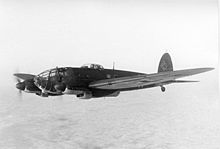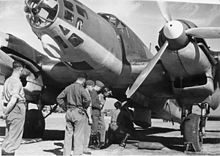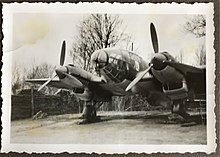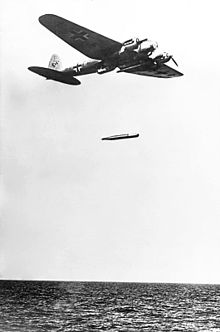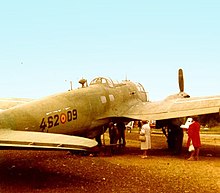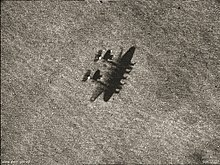Heinkel He 111
| Heinkel He 111 | |
|---|---|
 Heinkel He 111H Heinkel He 111H
|
|
| Type: | bomber |
| Design country: | |
| Manufacturer: | |
| First flight: |
February 24, 1935 |
| Commissioning: |
1936 |
| Production time: |
1936 to 1944 (as CASA 2.111 to 1956) |
| Number of pieces: |
7603 |
The Heinkel He 111 was a twin-engine aircraft from German production, manufactured from 1935 to 1944 by Ernst Heinkel Flugzeugwerke in Rostock and Heinkel-Werke Oranienburg , mainly for the Air Force . The aircraft was also produced in Spain and used there until 1976. The cantilever low- wing aircraft in all-metal construction with retractable landing gear was a design by Siegfried Günter and built heavily on the experience with the single-engine He 70 high-speed airliner .
development
The plane was designed in the 1930s by the Günter brothers as a fast airliner for Lufthansa for a crew of two and ten passengers and was later used in large numbers as a bomber during World War II .
As early as 1932, the Reich Ministry of Transport (RVM) gave the order to develop a bomb and commercial aircraft, whereby the bomber variant (still secret) had priority. The He 111 V1 (serial number 713, 1st military version) took off on its maiden flight on February 24, 1935 . The He 111 V2 (W.Nr. 715) followed on April 12, 1935 as the first civilian prototype. This and the fourth prototype flew as a transport machine, with the He 111 V4 and the first pre-series He 111 A-0 already showing the conception as a bomber. In the course of the tests, various changes were made, for example the installation of more powerful engines of the type DB 600 (He 111 B) , as the air force required a higher speed. Because the aerodynamically high-quality airframe was very expensive, attempts were made from 1936 to reduce costs by introducing new wings: from the He-111-F series onwards, all aircraft were given trapezoidal wings, which compared to the straight front and rear wings used up until then Had trailing edges.
commitment
The Air Force received its first He 111 B in late autumn 1936. The first combat mission of the pattern took place in March 1937 at the Spanish Civil War , when the battle group 88 of the Condor Legion 30 He 111 B-1 (Spanish nickname "Pedro") against the Republic were used . Before that, a few specimens had already been tested in action by the test bomber squadron 88 from the beginning of the year . The He 111 E and He 111 F models were also used in Spain and were taken over by the Spanish Air Force after the end of the war.
Due to the experience of the Spanish Civil War , the Air Force did not have sufficient defensive armament in its He 111, as the He 111 flew faster than most of the enemy’s available fighters. In the Battle of Britain , however, it became clear that an exemplary defense with powerful fighters could inflict heavy losses on unprotected bomber formations.
With almost 1,000 aircraft delivered in 1939, the He 111 was the Luftwaffe's standard bomber and as such remained in service on all fronts during World War II . At the beginning of the war, the Kampfgeschwader 1 , 4 , 26 , 27 , 28 , 53 , 54 , 55 and 100 as well as the Lehrgeschwader 1 were equipped with it. In the meantime, the He 111 P version with a fully glazed fuselage nose was built, the production of which was limited to a small number of pieces due to the scarcity of the DB 601 engines required for fighter aircraft construction . The standard model was therefore the He 111 H with Jumo 211 engines, which, based on the experience gained during the Battle of Britain, was given several times more defensive armament.
He 111 were each equipped with two torpedoes as torpedo bombers . Some aircraft were armed with Hs 293 glider bombs or as carriers of the V1 . The five-engine He 111 Z , which was assembled from two He 111s, was particularly idiosyncratic . The versions He 111 H-8 with balloon cable knives for use against blocking balloons and the H-23 as an eight-seat transporter for paratroopers were also noteworthy .
A Heinkel He 111 H, built on January 7, 1939 near Arado in Brandenburg an der Havel , and a Junkers 88 landed in April 1940 during the invasion on a frozen lake near Trondheim , Norway and later broke while they were waiting for use. a Norwegian pilot reported to Holger Steinle , an "aircraft archaeologist" who works for the German Museum of Technology , that they both sank in the onset of warm weather . Using sonar, two aircraft close together at the bottom of the lake, which is used to supply the city of Trondheim with drinking water, could be tracked down. Because of the great water depth of almost 80 m, an underwater robot from Saastad AS was used - the rescue was directed by Espen Saastad. The He 111 lying on the back at the bottom was drilled by remote control on both wings, hung on ropes and - after more than 60 years, in 2003 - pulled up to a pontoon and towed close to the shore. Using a truck-mounted crane, it was lifted in the air and further on land without breaking it. A small amount of fuel spilled was bound by a floating oil barrier . The plane was so well preserved that the wings could be unscrewed.
He 111 were involved in the destruction of the northern sea convoy PQ-17 as well as as transport aircraft in supplying the 6th Army in the Battle of Stalingrad or in the operation in Iraq in 1941 .
On the night of June 22nd to 23rd, 1944, a group of He 111 and Ju 88 bombs destroyed 43 US bombers on the Poltava airfield , which had landed there as part of Operation Frantic , and damaged 26 others.
Foreign use
In Spain the He 111 B with the registration number 25-32 was captured by the republican armed forces after an emergency landing, brought to the Soviet Union and extensively tested in the Moscow Scientific Institute under the name Samoljot (airplane) 31, with some technologies being adopted for the Soviet air forces were. For example, the bomb sighting device was copied and later found in the types IL-4 , Tu-2 , Jer-2 and Pe-8 use. A captured during the Second World War He 111 H was at the flying school Saratov as a glider - towing aircraft used and flew in this function with an A-7 also has a commitment to supply partisans in the enemy hinterland, but was shot down on the return flight of their own fighters.
From 1941 the Luftwaffe received the He 111 P-3 school version with double controls. In the course of the war, the He 111 were used as a transporter, torpedo bomber and tow plane in addition to their actual task. A special version was the He 111 Z , a double-fuselage design with five engines created by inserting the wing center section.
30 He 111 F-1 and 5 He 111 G-5 were delivered to Turkey as well as several He 111 B and He 111 E to the fascist Franco Spain.
Until 1956, the Spanish company Construcciones Aeronáuticas SA (CASA) in Tablada ( Seville ) had manufactured around 250 copies of the He-111-H-16 licensed version CASA 2.111B. These He-111 offshoots were bombed during the Ifni War against Morocco in 1957 and were in service with the Spanish Air Force until the 1970s. A striking distinguishing feature are the large coolers under the engines, which indicate the Rolls-Royce-Merlin engines used in the 2.111B . This became necessary because the German Daimler-Benz engines, as they were also used in the 2.111A, and matching spare parts were hardly available after the end of the war. CASA 2.111B were used as He-111 doubles in the Battle of Britain movie .
production
In addition to production at Heinkel in Rostock (Ernst Heinkel Flugzeugwerke, EHF) and Oranienburg ( Heinkel-Werke Oranienburg , HWO), the machine was licensed to Norddeutsche Dornier-Werken (NDW) in Wismar, Arado (ArB) in Brandenburg , the Allgemeine Transportanlagen-Gesellschaft (ATG) in Leipzig and at Junkers Flugzeug- und Motorenwerke (JFM). Production ran from March 1936 to September 1944.
| version | EHF | ND W | HWO | ArB | ATG | JFM | TOTAL |
|---|---|---|---|---|---|---|---|
| Prototypes | 4th | 4th | |||||
| A-0 | 10 | 10 | |||||
| A. | 6th | 6th | |||||
| B-0 | 7th | 7th | |||||
| B. | 136 | 283 | 419 | ||||
| C. | 12 | 12 | |||||
| D. | 30th | 30th | |||||
| E. | 80 | 50 | 40 | 40 | 210 | ||
| F. | 45 | 45 | |||||
| G | approx 8 | approx 8 | |||||
| J | 120 | 120 | |||||
| L (conversion) | (6) | ||||||
| P-1 | 75 | 20th | 95 | ||||
| P-2 | 451 | 288 | 739 | ||||
| P-4 (conversion) | (156) | ||||||
| H-1 | 95 | 21st | 20th | 136 | |||
| H-2 | 180 | 182 | 140 | 502 | |||
| H-3 | 182 | 196 | 126 | 504 | |||
| H-4 (conversion) | (117?) | (117?) | |||||
| H-5 | 560 | 560 | |||||
| H-6 | 1745 | 1745 | |||||
| H-6tp | 30th | 30th | |||||
| H-11 | 301 | 301 | |||||
| H-11 TO | 200 | 200 | |||||
| H-14 | 50 | 50 | |||||
| H-16 | 200 | 200 | |||||
| H-16 / R1 | 900 | 900 | |||||
| H-20 | 770 | 770 | |||||
| Z | (12) | (12) | |||||
| TOTAL | 5657 | 671 | 577 | 449 | 326 | 40 | 7603 |
Versions
Prototypes
- He 111 V1: The first He 111, equipped with a BMW VI 6.0 Z.
- He 111 V2: It was purely a passenger and mail plane that could carry ten people and had a reduced wingspan.
- He 111 V3: The first pure bomber version, also with a reduced wingspan.
- He 111 V4: A civilian prototype from which five He 111 C series machines were derived, which were used by Lufthansa . It was officially presented on January 10, 1936.
- He 111 V5: last prototype; it was equipped with more powerful DB-600- A engines and, thanks to its greatly improved performance, formed the basis for the first larger series of He 111 B bombers. The first flight took place in early 1936.
Serial pattern
- He 111 A-0: The bomber pilot series, built in ten copies, was used entirely as a prototype. In 1936 six He 111 A were exported to China.
- He 111 B: Heinkel now equipped the He 111 with more powerful engines (1000 HP each) and called this series He 111 B (417 km / h). The Luftwaffe introduced this machine at the beginning of 1937 under the designation He 111 B-1 with DB-600-C engines. The B-2 had improved engines DB 600 CG and a stronger bow armament. From March 1937, 30 units were tested in real use by Kampfgruppe 88 of the Condor Legion .
- He 111 C: Five pieces were built for Lufthansa, see also He 111 V4 .
- He 111 D: A more powerful version with DB-600-Ga engines (each 1050 PS, 460 km / h), which was not built for a long time because Daimler-Benz was at full capacity with the production of engines for the Bf 109, for example . It was used as a command aircraft.
- He 111 E: The E series already flew 498 km / h (better cooler). The E-1 and E-3 series were also used in Spain, with a total of almost 100 machines (including the B-1).
- He 111 F: 30 of the F series were sold to Turkey, some others were used by the Condor Legion. In this series, the wing leading edge and the engine were changed. All types still looked similar to the A series. The poor visibility for the crew was criticized. This and other shortcomings led to the development of the He 111 P.
- He 111 G: Trying to find more civilian customers. Mostly with DB 600A / G engines. Two machines of the G-3 series were equipped with radial engines on a trial basis (BMW 132Dc and BMW 132H). They came to Lufthansa and were called the He 111 L there.
- He 111 J: 90 pieces ordered by the Air Force as torpedo bombers.
- He 111 P: The P series had a streamlined nacelle on the underside of the fuselage, a fully glazed bow and DB-601 engines with 1100 hp each. It was delivered to the Luftwaffe in early 1939. It replaced the machines in the B and C series.
- He 111 H: The H series was the most important series version. It was largely identical to the P, but used Jumo 211 engines. However, it soon became apparent from their high casualties that the machines were armed too slowly and too weakly for the RAF fighters. The missions were postponed into the night, the defensive armament was reinforced. The engines have also been improved again and again (H-2, H-3, H-4, H-5). The H-4 / -5 / -6 / -11 could use torpedoes. From the H-20 onwards, the upper defense post was replaced by a power-operated rotating tower. The H-16 / -20 / -22 could fire V1 guided missiles . The models H-8 to H-23 were built until 1944 for lack of better aircraft types.
- He 111 Z: The Zwilling consisted of two aircraft that were connected to each other by a wing center section. A fifth engine was installed at the coupling point. From 1942, due to the lack of other powerful aircraft, a small number of these machines were built for towing large cargo gliders (such as the Me 321 ). This replaced the dangerous "Troika" towing procedure with three individual Messerschmitt Bf 110s . The five liquid-cooled twelve-cylinder V-engines of the He 111 Z together delivered a starting power of 6700 HP, which was enough to tow a cargo glider of the type Me 321 or three Go 242s. In the event of overload starts, rocket starting aids were still necessary. A steel cable 150 m long and 16 mm in diameter was used to tow the Me 321. When towing with two Go 242, a 60 m long steel cable was used for the first sailor and a 40 m long steel cable for the next.
Technical specifications
| Parameter | He 111 P-4 (1939/1940) | He 111 H-6 (1941/1942) | He 111 H-16 (from autumn 1942) | He 111 Z |
|---|---|---|---|---|
| crew | 5 | 7th | ||
| length | 16.38 m | |||
| span | 22.50 m | 35.20 m | ||
| height | 3.40 m | 3.93 m | ||
| Wing area | 87.60 m² | 86.50 m² | 147 m² | |
| Empty mass | 6,775 kg | 8,680 kg | 21,400 kg | |
| Takeoff mass | 13,500 kg | 14,000 kg | Max. 14,000 kg | Max. 28,400 kg |
| Top speed | 390 km / h, fully loaded approx. 330 km / h | 400 km / h, fully loaded approx. 330 km / h | 436 km / h at an altitude of 6000 m | 435 km / h at an altitude of 8000 m |
| Cruising speed | 290 km / h | |||
| Towing speed | 219 km / h with 1 Me 321 248 km / h with 2 Go 242 |
|||
| Landing speed | 115 km / h | |||
| Climb performance | 2.4 m / s | |||
| Climbing time to 6000 m | 42 min | |||
| Summit height | 8000 m | 6700 m | 10,000 m | |
| Range | fully loaded 1200 km, max. 2400 km | fully loaded 1200 km, max. 2400 km | 2900 km (with 1000 kg bombs) | |
| Engines | two Daimler-Benz DB 601 A-1s with 1,100 hp (809 kW) each | two Junkers Jumo 211 D with 1,200 PS (883 kW) each | two Junkers Jumo 211 F-2 with 1,350 HP (993 kW) each | five Junkers Jumo 211 F-2, each with 1,350 PS (993 kW) |
| Armament | five movable 7.92 mm MG 15 , optionally two additional 13 mm MG 131 |
One 20 mm MG / FF (bow), five movable 7.92 mm MG 15, optionally two 13 mm MG 131 |
one 20 mm MG / FF (bow), one 13 mm MG 131 or one 7.92 mm MG 81 -Z twin (back of the fuselage) , two 7.92 mm MG 81 (underside of the fuselage) , two 7.92 mm MG 81 (sides) |
one 13 mm MG 131 (A stand), four 7.92 mm MG 81 (B and C stand), two 7.92 mm MG 81 (window mounts) |
| Bomb load | 2000 kg internally | 2500 kg | 3000 kg | - |
Electronic equipment
The He 111 was equipped with an on-board communication system, radios and an autopilot as standard. The machines used for night flights also had a receiver so that the landing approach could take place exactly along the emitted beacon. The airfield lighting was only switched on shortly before touchdown so that the airfield could not be seen by enemy aircraft.
Some aircraft were equipped with target navigation ( Knickebein method , X method , Wotan). These He 111s could be recognized by the fact that they carried three rod antennas on the fuselage. In the procedure using the X-device (70 MHz), the pilot flew along a beacon (called Weser). Deviations from the beacon were signaled to him through headphones. The guide beam was crossed by three aiming beams as at right angles as possible in the target area in order to achieve a high level of accuracy. The first target beam was crossed about 30 km from the target. The pilot knew from the signal that he would reach the destination in about five minutes. When the second target beam crossed, a computer was started that calculated the exact speed of the aircraft over the ground. From the measured speed, the computer determined the drop point, which had to be shortly before the target. Since the two measuring points of aiming beam 2 and 3 were equally far apart, the computer determined the time still to fly to the target. The times were also displayed visually. The altitude was entered as a further parameter. The bombs were then automatically dropped. The accuracy of this method (X device) corresponded to that of the target devices used during the day.
Altitude ventilation system
The Heinkel He 111 H had 20 oxygen bottles, each weighing 2.62 kg, on board as a safety and rescue device. These were 10 pieces each - arranged on the left and right in the aircraft and connected to one another.
Preserved copies
A He 111 E, the former 25.82 of Kampfgruppe 88 of the Condor Legion , is in Madrid in the Museo de Aeronáutica y Astronáutica .
A He 111 P-2 (5J + CN), serial number 1526, is on display in the Royal Norwegian Air Force Museum in Gardermoen .
A He 111 H-20 is on display at the Royal Air Force Museum , the United Kingdom's Air Force Museum .
License building CASA 2.111

After the Spanish Civil War, CASA built the He 111 H-16 under the name CASA 2.111 in Seville (Spain) from 1940. Since the Jumo 211 engines were no longer available, British Rolls-Royce Merlin 500 engines were installed. Due to problems with the production equipment, the first flight took place on May 23, 1945 from the Aeródromo de Tablada . CASA built 236 machines in three versions as bomber, reconnaissance and passenger aircraft, which were in service with the Ejército del Aire as light bombers until the end of the 1960s and were then used as transport aircraft until 1973.
Numerous CASA 2,111 were used in movies to portray the He 111, like in Patton - Rebel in Uniform and Battle of Britain .
CASA 2.111 B can be viewed in the Schleissheim airfield in Munich, in the Military History Museum of the Bundeswehr - Berlin-Gatow airfield, and in the Sinsheim Museum of Car and Technology . A CASA 2.111 D (WNr.145) is in the flight exhibition L. + P. Junior at Hermeskeil .
Another machine is in the Musée de l'air et de l'espace at Le Bourget Airport in Paris
See also
literature
- Olaf Groehler : History of the Air War 1910 to 1980 . Military publishing house of the German Democratic Republic , Berlin 1981.
- Friedrich König: The History of the Air Force . Rastatt 1980.
- Kenneth Munson: Bombers, Patrol and Transport Aircraft 1939–45 . 3. Edition. Orell Füssli, Zurich 1977.
- Manfred Griehl: Heinkel He 111 . Motorbuch, Stuttgart 1997, ISBN 3-613-01841-1 .
- Peter W. Cohausz: German aircraft until 1945 . Aviatic Verlag, Oberhaching 2011, ISBN 978-3-942645-00-3 .
- Andrei Alexandrov, Gennadi Petrov: The German aircraft in Russian and Soviet service 1914–1951. Volume 1, Flugzeug Publikations GmbH, ISBN 3-927132-43-8 .
Web links
- Restoration of the Heinkel He 111 H-16 (CASA 2.111B) in the Schleissheim aircraft yard of the Deutsches Museum
- Video of the Heinkel He 111 "D-AMUE", equipped with two Walter rocket launchers (Peenemünde-West, May / June 1938), with original audio commentary by the pilot Erich Warsitz - the world's first jet pilot
- Entry to Casa 2.111 (replica of He 111 H16 (G1 + AD)) of the Military History Museum of the Bundeswehr - Berlin-Gatow airfield on Museum Digital
Individual evidence
- ↑ KH Regnat: From riginal to the model - Heinkel He 111 . Bernard & Graefe, Bonn 2000, p. 12 .
- ↑ Company Saastad in Norway
- ↑ wocomoDOCS: Sunken war plane from 1939 reappears! A Heinkel 111 is recovered youtube.com, March 11, 2017, retrieved July 1, 2018 - Video (7:54).
- ↑ cf. Ernst König: The History of the Air Force. Rastatt 1980, p. 140.
- ↑ Wladimir Kotelnikow: Prey bomber Heinkel He 111. In: Klassiker der Luftfahrt No. 5/2014, pp. 26-29.
- ↑ Horst Boog , Gerhard Krebs, Detlef Vogel: Das Deutsche Reich and the Second World War, Volume 7 , dva, Stuttgart 2001, ISBN 3-421-05507-6 , p. 392.
- ↑ RAF Museum London: Heinkel He 111 H-20 ( Memento of the original from September 5, 2008 in the Internet Archive ) Info: The archive link was inserted automatically and has not yet been checked. Please check the original and archive link according to the instructions and then remove this notice.
- ↑ The restoration project CASA 2.111B (Heinkel He 111 H-16)
- ^ Deutsches Museum: He 111
- ↑ cf. Peter W. Cohausz: German aircraft until 1945. Aviatic Verlag 2011, p. 183.
- ↑ Casa C-2.111D BR.21 Pedro Heinkel He 111H-16. Musée de l'air et de l'espace , accessed on July 21, 2020 (French).
